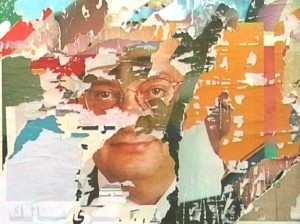Video screening by Jalal Toufic

Video screening of 3 of his videos followed by talk by thinker and artist Jalal Toufic, at Nikolaj Copenhagen Center of Contemporary Art, Nikolaj Square 10, DK-1067 Copenhagen K, Sunday 16 August 3:00-5:00 PM:
Irruptions of the Real
“On several occasions on which I wondered incredulously, “Is this real?” for example when facing the parliamentary candidates’ smug faces on the kitschy posters and photographs that lined most of the walls of Lebanon’s cities during the election campaign of 2000, various irruptions of the Real occurred (was I at all tempted to view them as an answer to my question?), for example the inorganic bodies that resulted from the accretions of these photographs and posters over each other and their partial removal.”
Jalal Toufic
Saving Face, video, 8 minutes, 2003.
Were all the candidates’ faces posted on the walls of Lebanon during the parliamentary campaign of 2000 waiting for the results of the elections? No. As faces, they were waiting to be saved. Far better than any surgical face-lift or digital retouching, it was the physical removal of part of the poster of the face of one candidate so that the face of another candidate would partially appear under it; as well as the accretions of posters and photographs over each other that produced the most effective face-lift, and that proved a successful face-saver for all concerned. We have in these resultant recombinant posters one of the sites where Lebanese culture in specific, and Arabic culture in general, mired in an organic view of the body, in an organic body, exposes itself to inorganic bodies.
The Sleep of Reason: This Blood Spilled in My Veins, video, 32 minutes, 2002.
The organic dying of a (resurrectable) human is as nothing compared to that of an animal, exemplarily of a bull in a corrida; the only phenomenon that equals in intensity the death of a bull in a corrida or of a cow in a slaughterhouse is the resurrection of a human, Lazarus coming out from the grave. The living woman in T. S. Eliot’s The Love Song of J. Alfred Prufrock is found settling her pillow to sleep when she encounters the undead. Why are you settling the pillow, why are you so sleepy? What disclosure are you thus trying to elude? “Tell you all,” Lazarus says in Eliot’s poem, and would that “all” not also include himself? Did Lazarus come back to tell himself about death? And did he find himself sleeping then?
Mother and Son; or, That Obscure Object of Desire (Scenes from an Anamorphic Double Feature), video, 41 minutes, 2006.
My experience of collaborating in an untimely manner with Gus Van Sant was not a happy one. Had he heeded my suggestions, he would not have tried to do a remake of Hitchcock’s Psycho (1960) in which he reproduced each frame of the original largely in the manner of Hitchcock, but would instead have done a Psycho in the manner of Sokurov, so that the resultant film would have been: Psycho, School of Sokurov (as The Betrothal, circa 1640-50, is by the School of Rembrandt). Such a programmatic film would have proved all the more appropriate when Sokurov went on to do a seemingly programmatic cinematic work, Russian Arc (2002), a 96-minute film videotaped in one continuous shot. Since Van Sant did not heed my suggestions for his remake of Psycho (1998), I did Mother and Son; or, That Obscure Object of Desire (Scenes from an Anamorphic Double Feature), 2006, in lieu of the failed untimely collaboration.